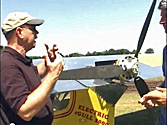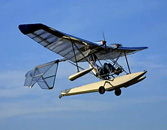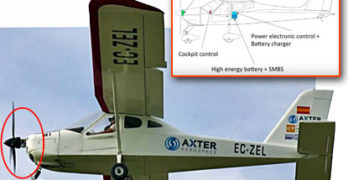Mark Bierle is one of the most talented designers I have ever met. The modest, soft-spoken Californian makes a line of the best-flying and genuinely light aircraft in the USA. He’s also worked in powerplant design and has now turned his agile mind toward electric power. We talk with him at some length about the advantages of electric-powered light aircraft and what Mark expects for the future.
Search Results for : electric
Not finding exactly what you expected? Try our advanced search option.
Select a manufacturer to go straight to all our content about that manufacturer.
Select an aircraft model to go straight to all our content about that model.
Electric Power — eLazair at AirVenture 2011
A vintage ultralight from the 1980s, the Lazair, returns in the hands of original designer, Dale Kramer, who has now removed the two small gasoline engines and replaced them with electric motors and batteries. Our video provides the details of how Kramer reformed his design and how crowds at AirVenture 2011 responded to the surprise debut.
Racing Down Electric Avenue … Here Comes Airbus
At the recently concluded Palm Springs Expo, a keynote address was provided by George Bye, the man behind the Sun Flyer project that aims to put electric two seaters into flight schools. Pipistrel is already selling into this market with its Electro (video) and while only a small number of aircraft are in use, the race is on for more … much more.
Airbus made big news back in July when a race developed to see who would cross the English Channel first in an electric powered airplane. Of course, the whole thing was a bit moot because it had been done years before. Longtime electric pioneer Eric Raymond of Sunseeker Duo noted, “It was already done in 1981 by the Solar Challenger, which flew from Paris to London at 14,000 feet. [Famous hang glider pilot and manufacturer Gerard] Thevenot even flew an electric trike across.
What’s with FAA’s Worry Over Electric Airplanes?
I’m always impressed with good turns of phrase and cleverly-worded presentations. Given that I am a writer, I suppose that doesn’t surprise you. However, I am even more impressed when someone can present a concept in such clear language that everyone gets it right away. Following is such a story.
My longtime friend and fellow board member, Tom Peghiny, participated in our annual Light Aircraft Manufacturers Association board of directors meeting at EAA AirVenture Oshkosh, where EAA kindly provides a quiet, air-conditioned space for our group to meet.
LAMA has four initiatives that the association is pursuing*. One of them is trying to break the logjam of electric propulsion
In an FAA-organized gathering on this and other subjects at AirVenture 2014, industry experts observed that FAA never intended to block electric power. Agency rulewriters were intent on preventing use of turbine engines on LSA so the regulation specifies reciprocating engines only, effectively blocking electric power even if doing so was never the goal.
Sleeker Is Better In Electric-Propelled Aircraft
If you’ve been following exciting developments like the Airbus/Pipistrel/Cri-Cri English Channel crossing, or for that matter any of the electric airplane developments, you should know that the ideal electric-powered aircraft today are the very lightest weight machines.
However, another quality is just as important while we wait for scientists to significantly amp up the energy density of batteries. That quality is sleekness and I’ve been watching a Norwegian project from Equator Aircraft. Airplanes don’t get much sleeker than this.
If it needed to be even more intriguing, consider that this project comes from a team that has also been involved with seaplanes, so how about a two-seat electric seaplane? OK, it isn’t ready yet but this is one I will continue to follow closely. Following is some detail on this fascinating entry that again suggests the tip of the spear in LSA design seems intently focused on seaplanes.
Equator’ Aircraft P2 Excursion (abbreviated EQP2) is envisioned as a performance hybrid amphibian aircraft.
Lightplane Electric Power … Pure or Hybrid?
With our friends at the prestigious Flying magazine putting Airbus’ E-Fan on their July 2015 cover, flanked by a major story inside, it seems everyone is following electric propulsion ever more closely. We’ve been doing it for a while as light aircraft are clearly the first place where electric power is best applied. Airbus may be planning an electric airliner but I don’t expect to see that anytime soon. Meanwhile the giant builder of airliners is indeed pushing forward with a two-and four-seat E-Fan.
However, I see another use of electric motors that strikes me as very compelling, and in the very near term. I wrote about a Spanish project earlier and here is another.
Many years ago when I was a young flight instructor, I dreamed up an idea called JERA, the Johnson Emergency Rocket Assist, born out of a small rocket engine that some gearheads were applying to go-carts on steriods.
Innovative Hybrid: Jet Power with Electric Motor
Some people, myself included, love soaring flight. As the following article from Dave Unwin explains, to use his words, “Soaring flight exercises a fascination that is both difficult to explain and hard to resist, sometimes called ‘three-dimensional sailing.’ Flying a heavier-than-air machine for several hours and hundreds of miles by using the atmosphere as the fuel possesses an undeniable attraction.” As he further explained in a longer article, the downside is getting airborne for soaring flight. Various alternatives have been explored. Some were reasonable; others were too marginal to be enjoyed. In the following piece Dave tells about a new aircraft that might solve this problem, one that can fit England’s innovative SSDR 300 (kilogram) category. —DJ
Article Updated 6/17/15 — ProAirsport announced, “We have now released a priority price of 39,950 British pounds (about $63,000). More details can be found on our website.” This is an excellent value for a motorglider.
Add-On Electric Motor Emergency & Boost Power
A few years back at Aero 2009, Flight Design and Rotax teamed up on a very interesting project. Based on the R-912 engine they added an optional electric motor that could provide additional torque (a characteristic electric motors have in abundance) for takeoff and climb or for emergency power in the event of a failure. The idea more than intrigued me and many others but it quietly disappeared.
Recently a Spanish university announced it had taken this concept to the next step. The team investigating this seemed focused on the emergency factor but opened the door to combined used of electric motor and gasoline engine. In case of a conventional engine failure, while very unlikely, an electric motor can, they said, deliver another 20 kilometers or 12.5 miles of range. That would be a literally saving grace to the pilot and occupants of a troubled aircraft.
Researchers at Universidad Carlos III de Madrid (UC3M) and the Axter Aerospace firm developed an electric propulsion system to install in light aircraft to deliver extra power and range in emergency situations.
Electric Flight Events to Advance State-of-the-Art
A new season of airshows is about to erupt now that April has arrived. Among all the gasoline-powered aircraft that show visitors can see will be a growing collection of electric aircraft. As I often repeat, the pioneering development of electric propulsion will come first in light aircraft … at least until batteries go through a major breakthrough in energy density, as today’s best cells still weigh far too much for larger aircraft to use them effectively.
First up, in mere days, is the e-flight-expo, organized in cooperation with Flying Pages, the company operated by European publisher Willi Tacke who is well known for his Directory of Leisure Aviation.
Aero officials said “e-flight-expo will again be a major section at Aero Friedrichshafen 2015.” They note that as in other industries such as automobiles and drones, electric power continues to gain in importance in the man-carrying aviation sector.
Rui Xiang RX1E … Certified Electric Two-Seater
All over the world, electric airplanes are getting remarkable amounts of attention, deservedly so as an exciting development to match work in cars and other vehicles. These days, while drones (also called UAVs, UASs, or RPVs) are made in various countries, a lot of the development comes from China … so why be surprised to hear of a positive development in a Chinese human-occupied aircraft?
Is it the first “certified” electric? Well, “certified” is a term that can be challenging to define as the word means different things in different countries. For example, we’ve already produced a video covering the American-designed, Chinese-developed eSpyder from Yuneec. It won German approval in 2013. My flying experience on eSpyder is documented in this article. You can also read a more encompassing electric aircraft review article from 2011, though with the rapid pace of development such articles become dated rather quickly.
- « Previous Page
- 1
- 2
- 3
- 4
- 5
- 6
- …
- 67
- Next Page »











